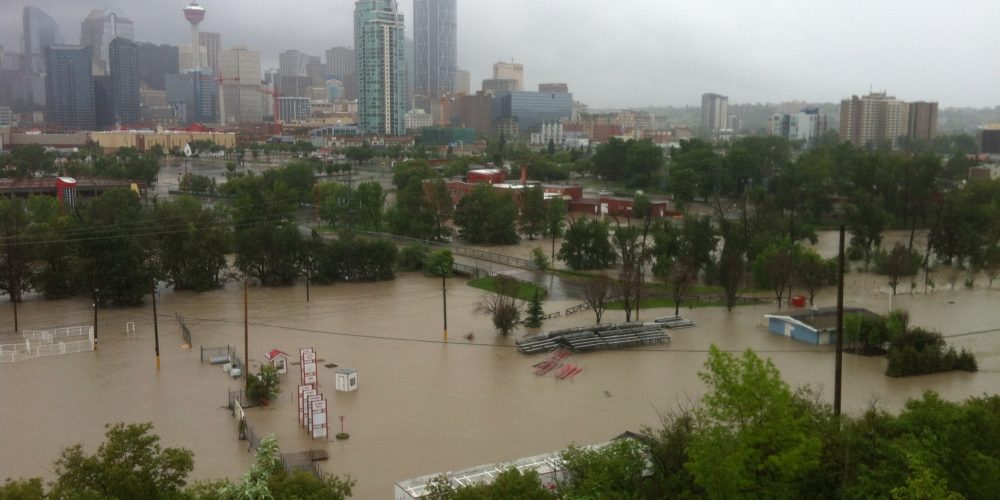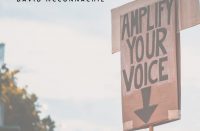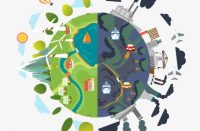On Sunday, I flew back to Kitchener, Ontario, after spending a little more than a week in Calgary. I’m not yet sure of the words I want to use to describe the Great Flood of 2013. I wish I could have stayed longer to assemble a bigger pile, to gather those words from the gradual fallout of this lightening-fast disaster. The moments, images and thoughts that draw meaning from such a mess tend to appear serendipitously, showing up in the wake of some invisible force — oddly enough, sort of like how eddies or floating curiosities show up on the surface of a huge, undulating river.
On Sunday, I flew back to Kitchener, Ontario, after spending a little more than a week in Calgary. I’m not yet sure of the words I want to use to describe the Great Flood of 2013. I wish I could have stayed longer to assemble a bigger pile, to gather those words from the gradual fallout of this lightening-fast disaster. The moments, images and thoughts that draw meaning from such a mess tend to appear serendipitously, showing up in the wake of some invisible force — oddly enough, sort of like how eddies or floating curiosities show up on the surface of a huge, undulating river.
The friends I was staying with are lucky enough to own a house in a Calgary neighbourhood called Ramsay, where property values are undoubtedly spiking as I type. Surrounded by the overdeveloped floodplain and low-lying residential areas in the oil capital’s core, this one knuckle of land stayed safe and dry when everything around it was washed out last Friday. Most of the images you’ll see of the drowned Stampede Grounds and Saddledome were taken from a mountain-facing lookout or an off-leash dog park atop Scotsman’s Hill, Ramsay’s high ground.
Starting from that very spot, I had taken a walk along the riverbank last Thursday afternoon, maybe two hours before I first learned that a few downtown neighbourhoods were being evacuated. Even then, with just some bike path underpasses and already swampy pockets of riverbank submerged, I noticed something unspoken in the roar (and unsettling rush) of both the Elbow and Bow rivers. By dinnertime I was helping friends move their cars to less vulnerable parking spots, making sure we had enough food, water, candles and money to last a few days, and wishing the heavy rain would taper. Tentatively, we went out to see a punk rock band at a bar on the other side of downtown – one of hundreds of shows in Calgary’s core during last week’s seventh annual Sled Island, a trailblazing music festival that became one of countless overnight casualties. Later that night, crossing the bridge back into Ramsay in the dwindling hours before it was blocked off, I finally grasped that we’d be waking up to a completely different city.
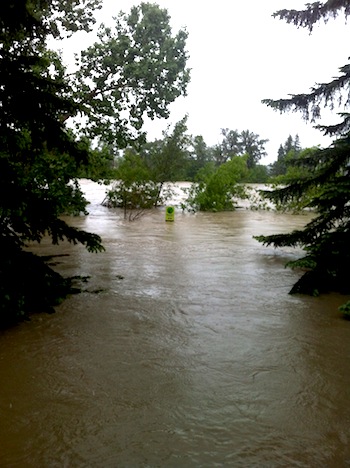 I spent much of the weekend hunkered down, soaked in awe. The next morning, that bridge into Ramsay had a fierce gurgle of chocolate milk-coloured water and a moustache of debris on its current-facing side. The Elbow River had risen at least six feet since I’d walked past it the day before, it had doubled in size and the water appeared to be moving twice as fast. In Inglewood, the neighbourhood next to Ramsay that was then in the process of being evacuated, the Bow inched toward the top of the berm that hems its riverside parkland. The owners of a local grocery store enlisted us to loot their freezers (and invite our friends) because they didn’t want their frozen goods to go to waste while the power was cut.
I spent much of the weekend hunkered down, soaked in awe. The next morning, that bridge into Ramsay had a fierce gurgle of chocolate milk-coloured water and a moustache of debris on its current-facing side. The Elbow River had risen at least six feet since I’d walked past it the day before, it had doubled in size and the water appeared to be moving twice as fast. In Inglewood, the neighbourhood next to Ramsay that was then in the process of being evacuated, the Bow inched toward the top of the berm that hems its riverside parkland. The owners of a local grocery store enlisted us to loot their freezers (and invite our friends) because they didn’t want their frozen goods to go to waste while the power was cut.
On Saturday we were equally stunned by how quickly the water receded. We could still hear the fierce growl of climate upheaval in the air, yet we were able to escape Ramsay on foot and explore the desolate calm of carnage in the East Village – the neighbourhood on a floodplain next to the Bow and Elbow’s convergence, slated to become one the city’s future cultural hubs. Streets that had been underwater on Friday were dry, cloaked in mud and waterlogged trash, and ominously empty. In the reflection of a rude lagoon that filled an excavated construction site, I watched a plane float across the warm blue sky. A couple of blocks away, under beaming sunshine and the drone of a large generator somewhere nearby, I wandered into an invisible bubble of gas, getting a big whiff of impending doom and feeling the pang of a headache. We approached a railway underpass, and the road suddenly disappeared into a sludgy pool of stranded floodwater, deep enough to have swallowed a small fleet of cube vans.
Much later that night, we ambled past a road closure checkpoint and down towards the south entrance of the Stampede Grounds. We found a 20-metre-wide bite out of one edge of the road, and a deep gash of land where the raging Elbow had carved a fresh bank. At an intersection we stood in the middle of the light rail train line, guffawing at the tributary that had replaced a tunnel just metres away.
The funny thing is that while all this devastation was engulfing the city’s heart, we witnessed almost no palpable sense of panic. Not to diminish the myriad contributions made by so many Calgarians to put safety first during the city’s second 100-year flood event of the last decade, but I attribute the lion’s share of that smooth, cool-headed reaction to one local: Naheed Nenshi. Calgary’s widely acclaimed (and deservedly so) mayor was the beacon in this horrendous storm. He was frank and forthcoming with details as they emerged, plainly relaying answers to the questions he was asking the front-line workers around him, leaving no shred of doubt about threats, necessities and precautions as things unravelled. The social media savvy that brought Nenshi to power in 2010 was the only news feed that mattered during the Great Flood, as conventional media quickly veered into disaster porn territory. And as he’s been doing since he took office, he turned a daunting challenge into a ripe opportunity to prove that transparency, straight talk and common sense can be so much more than mere buzzwords in the realm of political leadership.
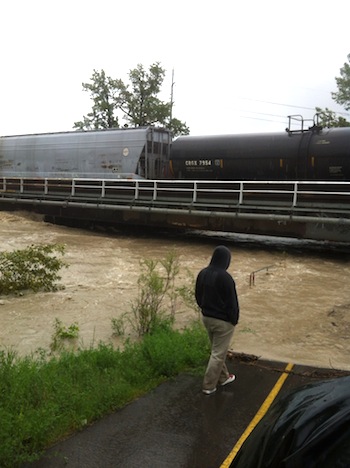 (An aside, in two parts, to exhibit what makes Nenshi’s approach so genuine and refreshing: Easily the least useful press conference last weekend was after Prime Minister Stephen Harper showed up, apparently having moved the scrum to an outdoor location overlooking the city and limiting questions from reporters – proving, by contrast, that even a massive tragedy can be turned into a tightly managed sideshow that serves the Conservative brand rather than the Canadian electorate. Exhibit B is a quote from Nenshi’s Sunday press conference, perhaps the best of many well-placed barbs that are but one sharp weapon in his troubleshooting arsenal: “I can’t believe I actually have to say this, but I’m going to say it. The river is closed. You cannot boat on the river. I have a large number of nouns that I can use to describe the people I saw in a canoe on the Bow River today. I am not allowed to use any of them. I can tell you, however, that I have been told that despite the state of local emergency, I’m not allowed to invoke the Darwin law.”)
(An aside, in two parts, to exhibit what makes Nenshi’s approach so genuine and refreshing: Easily the least useful press conference last weekend was after Prime Minister Stephen Harper showed up, apparently having moved the scrum to an outdoor location overlooking the city and limiting questions from reporters – proving, by contrast, that even a massive tragedy can be turned into a tightly managed sideshow that serves the Conservative brand rather than the Canadian electorate. Exhibit B is a quote from Nenshi’s Sunday press conference, perhaps the best of many well-placed barbs that are but one sharp weapon in his troubleshooting arsenal: “I can’t believe I actually have to say this, but I’m going to say it. The river is closed. You cannot boat on the river. I have a large number of nouns that I can use to describe the people I saw in a canoe on the Bow River today. I am not allowed to use any of them. I can tell you, however, that I have been told that despite the state of local emergency, I’m not allowed to invoke the Darwin law.”)
Before this post becomes a rant, let me tell you why I’m sharing these particular words about what I saw happen in Calgary last week. The Great Flood has set a new high water mark for the visible, measurable, harrowing repercussions of climate change in Canada. Depending on what happens in the coming weeks, months and years, Calgary’s rebuilding requirements may very well give way to a new high water mark for climate change adaptation in Canada, especially if Nenshi remains at the helm after this fall’s municipal election. While federal Immigration Minister Jason Kenney (who hails from a Calgary riding) has already made sure to dismiss climate change’s role in all of this, the rest of us should make no mistake: the havoc wreaked upon the Canadian oil industry’s epicentre is a reality check of epic proportions, and it will enlighten many deniers.
Any political leader unfortunate enough to preside over another (inevitable) natural disaster need look no further than Nenshi’s performance as a playbook for how to weather the storm. And if the rest of us are anywhere near as smart as Calgary’s mayor, we’ll make sure our next wave of elected leaders is just as capable of accepting and relaying actual facts about the rapid, perilous changes taking shape around us, rather than buying into elaborate fictions designed to cash in on an unsustainable way of living that is clearly drowning in the age of climate change.
Eric is the founder and executive director of Night\Shift, downtown Kitchener’s nocturnal adventure festival, and he helped craft the rebranding of A\J as its editor-in-chief (2012-2014). He has a dusty Bachelor of History from uWaterloo and has worked as a journalist in Canada since 2000, holding editing positions with up! Magazine (WestJet Airlines’ in-flight publication), Adbusters, Reade


